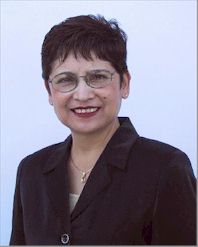|
Luce Faculty Seminar
2002

Health
Disparities in the U.S.A.
|
Welcome
Mario Incayawar, M.D., M.Sc.
Henry R. Luce Professor in Brain, Mind and Medicine:
Cross-Cultural Perspectives
Pitzer, Claremont McKenna, Harvey Mudd Colleges.
Opening Address
Alan Jones
Vice President and Dean of Faculty
Pitzer College
|
First
Session
March 15
Introducer
Cristina Leal, CMC Student
|
Second
Session
April 12
Introducer
Siobhan Acosta, Pitzer Student |
|
 Determinants of Cancer Mortality and Cancer Survival
Among American Indians and Alaska Natives
Determinants of Cancer Mortality and Cancer Survival
Among American Indians and Alaska Natives
Nathaniel
Cobb, M.D.
|
 Barriers to Health Care Access for
Latino Children
Barriers to Health Care Access for
Latino Children
Glenn
Flores, M.D.
|
 Language Barriers - Who's at Risk Patient or
Provider?
Language Barriers - Who's at Risk Patient or
Provider?
Yolanda
Partida, M.S.W., D.P.A. |
 Patterns of Cardiovascular Morbidity
and Mortality among African Americans and Latinos.
Patterns of Cardiovascular Morbidity
and Mortality among African Americans and Latinos.
Sean
O. Henderson, M.D.
|
 Racial Profiling and the Treatment
of Pain
Racial Profiling and the Treatment
of Pain
Knox
H. Todd, M.D., M.P.H. |
 Economic Benefits to Society Resulting
from Elimination of Health Disparities
Economic Benefits to Society Resulting
from Elimination of Health Disparities
Robert
H. Topel, Ph.D.
|
Moderator:
Prof. Frederick H. Lynch
Department of Government
Claremont McKenna College |
Moderator:
Prof. Ann Stromberg
Peter and Gloria Gold Professor of Sociology
Pitzer College |
|
Location
First Session: Pickford Auditorium,
Bauer Center, Claremont McKenna College, 500 Ninth Street, Claremont.
Second Session: Hampton Banquet
Room, Malott Commons, Scripps College, Ninth Street and Colombia Avenue,
Claremont.
Time
10:00 AM to 12:30 PM
Lunch-discussion
First Session: McConnell Living Room, Pitzer. Second
Session: Hampton Living Room, Malott Commons, Scripps College |
Driving Directions and Maps
Pickford Auditorium, Bauer Center, Claremont
McKenna College
Directions
& Campus Map
Hampton Banquet Room, Malott Commons, Scripps
College
Directions
& Campus Map
McConnell Living Room, McConnell Center, Pitzer
College
Directions & Campus Map
NOTICE
Unequal
Treatment: Confronting Racial and Ethnic Disparities in Health Care
A breakthrough report by the Institute of Medicine presents evidence that
ethnic groups
in the United States tend to receive lower-quality health care.

|

|
Nathaniel Cobb,
M.D.
Determinants of Cancer
Mortality and Cancer Survival among American Indians and Alaska Natives
Friday, March 15
American Indian and Alaska Natives (AI/AN)
represent one of the most vulnerable populations in the United States,
with heavier burdens of many disease categories (diabetes, injury, alcohol
related deaths, tuberculosis, suicide, etc.) and more unfavorable measures
of health and economic status (infant mortality rate, life expectancy,
poverty rate) than all other ethnic groups in the US. Once considered very
rare among AI/AN, cancer is now their second leading cause of death. There
is a remarkable variation of cancer rates among tribes, which may be
caused by genetic, environmental, or behavioral differences. Although
overall rates of cancer among AI/AN are still lower than the US all-races
rates, 5-year survival from cancer is much worse than other groups. In
this presentation I will describe geographic patterns of cancer mortality
among AI/AN and advance hypotheses to explain the variability. I will also
present results of research that attempts to explain the disparity in
cancer survival rates through analysis of various characteristics of the
patient (age, distance from hospital, frequency of visits, other
conditions) and the health care system (missed opportunities, referral
patterns, screening).
Dr. Cobb received his undergraduate degree
from Fort Lewis College in Durango, Colorado and his M.D. from Harvard
Medical School. He trained in Family Practice at the University of New
Mexico, and after practicing with Indian Health Service for several years,
he completed the two year Epidemic Intelligence Service fellowship at the
Centers for Disease Control and Prevention in Atlanta. Dr. Cobb also
completed the academic portion of the Cancer Prevention and Control
fellowship at the National Cancer Institute.
Dr. Cobb is currently Director of the
Chronic Disease Epidemiology Section of the Indian Health Service National
Epidemiology Program, Chief Medical Officer for IHS National Programs, and
Director of the IHS Cancer Prevention and Control Program. In addition to
his IHS duties, he teaches at the University of New Mexico MPH program and
maintains a part-time clinical practice in Emergency Medicine. He also
races bicycles and tries to stay ahead of two teenage sons.
References:
 | Patterns of Cancer Mortality among
Native Americans. Cancer 1998;83:2377-83. MEDLINE |

|
|

|
Yolanda Partida,
M.S.W., D.P.A.
Language Barriers -
Who's at Risk Patient or Provider?
Friday, March 15
A growing body of research on health
disparities between ethnic groups is making increasingly clear the case
that being a member of a minority group in the United States, in and of
itself, can be a barrier to health care. And though socioeconomic status
and ethnicity are only two elements in the larger picture of access to
care, statistically they have shown to be critically important.
The inability to speak English, in particular, has been empirically
associated with less care-seeking and diminished access.
In her presentation, Dr. Yolanda Partida
will address the issue of language barriers in health care and will ask
the question: who is at risk—patient or provider? She will then
introduce a new national program, the Robert Wood Johnson Foundation
called Hablamos Juntos, or We Speak Together. The program, housed at the
Tomás Rivera Policy Institute at Pitzer College, will aim to improve
communication between health care providers and their patients with
limited English proficiency through the use of 10 test sites around the
U.S. over the course of four years.
Dr. Partida is the director of the National
Hablamos Juntos Program, and Health Policy Director of the Tomás Rivera
Policy Institute. She has extensive experience in public/teaching
and private hospital administration, as well as public policy and public
health administration, and is the founder and Executive Director for The
Partida Group, a Latina-owned, health policy, research and management
consulting firm specializing in diverse populations.
While working as Assistant Hospital
Administrator for Valley Medical Center, a public hospital, Dr. Partida
worked with a local community college to develop a hospital-based
Interpreter Training Program. This program worked to define the role of
the interpreter and improve interpreter competency. Dr.
Partida and program staff learned that the process of establishing
interpreter programs within existing health care organizations can
illuminate culturally insensitive organizational practices. The existence
of such practices highlights the importance of training staff on how to
use interpreters. In addition to her current work with Hablamos
Juntos, Dr. Partida is also working with an Institute of Medicine
committee to study effective health communication and behavior change
strategies for diverse populations. The overall goal of this study is to
develop recommendations that will increase the efficacy of public health
communication and behavior change interventions targeted toward culturally
and demographically divergent populations.

|
|

|
KNOX H. TODD, M.D.,
M.P.H.
Racial Profiling and
the Treatment of Pain
Friday, March 15
When considering issues involving pain
management in the cross-cultural setting, ethnic disparities are likely to
be magnified for a number of reasons. Healthcare providers often view pain
as only a clue to underlying pathology, rather than as an entity deserving
of treatment in and of itself. The degree to which the amelioration of
pain is felt to be important is likely to be greater for those patients
that the provider identifies with more closely, usually the ethnic
majority group. statement and interpretation of the pain experience are
also affected by the health professional’s and patient’s understanding
of the underlying meaning of pain. This meaning and the behaviors
associated with pain-related behavior are inextricably tied to cultural
norms and perceptions and may be more difficult to communicate when the
health professional’s and patient’s ethnicities are discordant. Also,
ethnic stereotypes may impair the ability of healthcare providers to
assess pain in a valid fashion.
In his presentation, Dr. Todd will examine evidence of ethnic disparities
in pain management and suggest approaches to better understand and
eliminate these inequalities. He will review studies from the emergency
department setting, oncology clinics, and the post-operative setting and
examine potential mechanisms that result in pain treatment disparities.
Dr. Todd received his MD from the University of Texas Southwestern Medical
Center and is board-certified in internal medicine and emergency medicine.
He received his MPH in epidemiology from the UCLA School of Public Health
in 1993 and currently holds the titles of Visiting Associate Professor in
the Rollins School of Public Health of Emory University in Atlanta and as
Medical Fellow to the National Highway Traffic Safety Administration in
Washington, DC.
Dr. Todd’s research interests include
pain management, injury control, clinical informatics, and health services
research. He has conducted seminal studies of ethnic disparities in
analgesic use in the emergency department setting. His publications have
appeared in the New England Journal of Medicine, JAMA, Annals of Emergency
Medicine, Academic Emergency Medicine, Academic Medicine, American Journal
of Medical Sciences, American Journal of Medicine, Journal of Emergency
Medicine, and Prehospital and Disaster Medicine. He has received numerous
grants and contracts from public and private sources, including the Agency
for Healthcare Research and Quality, the National Highway Traffic and
Safety Administration, the CDC’s National Center for Injury Prevention
and Control, the Electric Power Research Institute, and the State of
Georgia.
References:
 | Bonham VL. Race, Ethnicity, and Pain
Treatment: Striving to Understand the Causes and Solutions to the
Disparities in Pain Treatment. Journal of Law, Medicine & Ethics,
29(2001): 52-68. MEDLINE |

|
|

|
GLENN FLORES, M.D.
Barriers to Health Care Access for
Latino Children
Friday, April 12
Latinos will soon be the largest minority
group in the United States, but too little is known about major access
barriers to health care for this community and whether these barriers
result in adverse consequences. In his cross-sectional survey of 203
parents of children coming to a pediatric Latino clinic, Dr. Flores found
that parents identified language problems, cultural differences, poverty,
lack of health insurance, transportation difficulties, and long waiting
times as the major access barriers to health care for their
children. According to Dr. Flores, language problems can result in
adverse health consequences for some children, including poor medical
care, misdiagnosis, and inappropriate medication and hospitalization.
Dr. Flores is Associate Professor of
Pediatrics and Public Health at the Boston University Schools of Medicine
and Public Health. He founded and is the Director of the Pediatric Latino
Clinic at Boston Medical Center. He is a former Robert Wood Johnson
Minority Medical Faculty Scholar and is currently a Robert Wood Johnson
Generalist Physician Faculty Scholar. He has published over 35 articles
and book chapters on a variety of topics, including access barriers to
health care for Latino children, the impact of ethnicity, family income,
and parental education on children's health and use of health services,
cultural competency in health care, and how a pediatric Latino clinic can
serve as a national model for providing health care to an under-served
population. He is a consultant on cultural and linguistic issues for the
Center for Mass Health Evaluation and Research at the University of
Massachusetts School of Medicine. Dr. Flores's current research
includes an investigation of medical interpreter errors and their clinical
consequences (funded by the Office of Minority Health), and a randomized
trial of case management to insure uninsured Latino children (funded by
AHRQ, CMS, and the Robert Wood Johnson Foundation).
References:
 |
Flores G, Abreu M, Olivar MA, Kastner
B. Access Barriers to health Care for Latino Children. Archives of
Pediatrics and Adolescent Medicine 1998:152:1119-1125. MEDLINE |

|
|
|
Sean O. Henderson,
M.D.
Patterns of Cardiovascular
Morbidity and Mortality among African Americans and Latinos.
Friday, April 12
Racism is not solely a psychological
phenomenon but rather is described as underpinning a whole variety of
factors related to health care. These include differences in socioeconomic
position, health related behavior, the experience of medical care, and the
ability to take action to maintain and improve health. Given the
similarity in median incomes and percentage of the population below the
poverty line, Latinos would be expected to experience similar racial
stresses as well as the added burden of very real language and cultural
barriers to health care. The ability of African American populations to
access care or their ability to afford such care have also been issues
raised as contributors to their increased mortality.
Latinos share these same obstacles and, in
fact, given that more dramatic language and cultural differences exist,
are even slower to access care than many other minority groups. Despite
the fact that both groups appear to have similar socioeconomic profiles
and at least somewhat similar access to health care, the relative burden
of cardiovascular disease is borne primarily by the African Americans.
After adjustment for the potential risk modifiers such as age and
lifestyle (e.g. smoking, body-mass index) and presence of hypertension,
African Americans in Los Angeles remain with an adjusted relative risk of
cardiovascular mortality higher than Latinos, an excess not immediately
attributable to any known modifiers. It suggests therefore, that even
though several environmental risk factors, such as obesity and cigarette
smoking, are well established, hypertension results from an interaction
between environmental and genetic influences.
References:
 |
Henderson SO, Coetzee GA, Ross RK, Yu
MC, Henderson BE. A Possible Association Between ACE Genotype and
Elevated Mortality Rates from Circulatory Disease in African-American
Men and Women of Los Angeles County, California. The American Journal
of Medical Sciences 2000;320:18-23. |
 |
Henderson SO, Magana RN, Korn CS, Genna
T, Bretsky PM. Delayed Presentation for Care during Acute Myocardial
Infarction in a Hispanic Population of Los Angeles County. Ethnicity
and Disease 2002;12:38-44. |

|
|
Robert H. Topel,
Ph.D.
Economic Benefits to Society
Resulting from Elimination of Health Disparities
Friday, April 12
Robert H. Topel is the Isidore Brown and
Gladys J. Brown Professor in Urban and Labor Economics at the University
of Chicago Graduate School of Business. He has been a member of the
Chicago faculty since 1986. He received a B.A. in economics (with high
honors) from the University of California at Santa Barbara in 1974 and a
Ph.D. in economics from the University of California at Los Angeles in
1980.
Professor Topel is the recipient of
numerous awards and fellowships. Currently, he is a Faculty Research
Fellow at the National Bureau of Economic Research and an Editor at the
Journal of Political Economy. He is the author or co-author of some 50
published articles and other publications. His most recent research has
focused on the economic value of medical research and issues in labor
markets and economic growth.
Professor Topel lives in the Chicago area
with his wife and two daughters.

|
 
|
